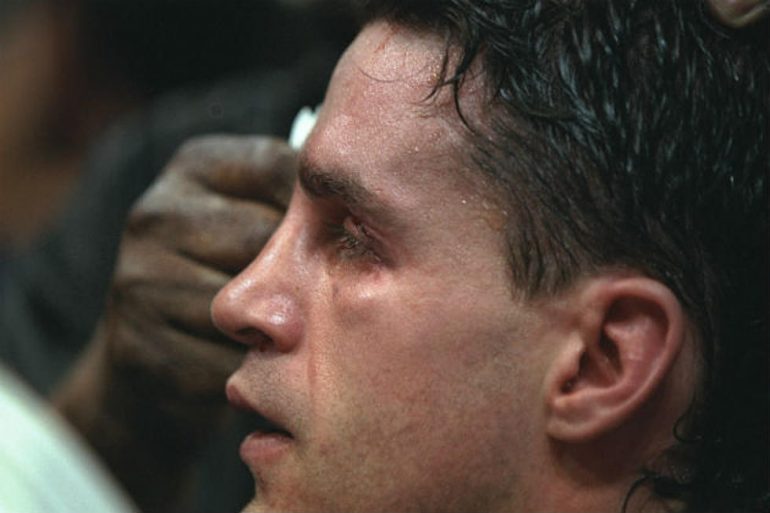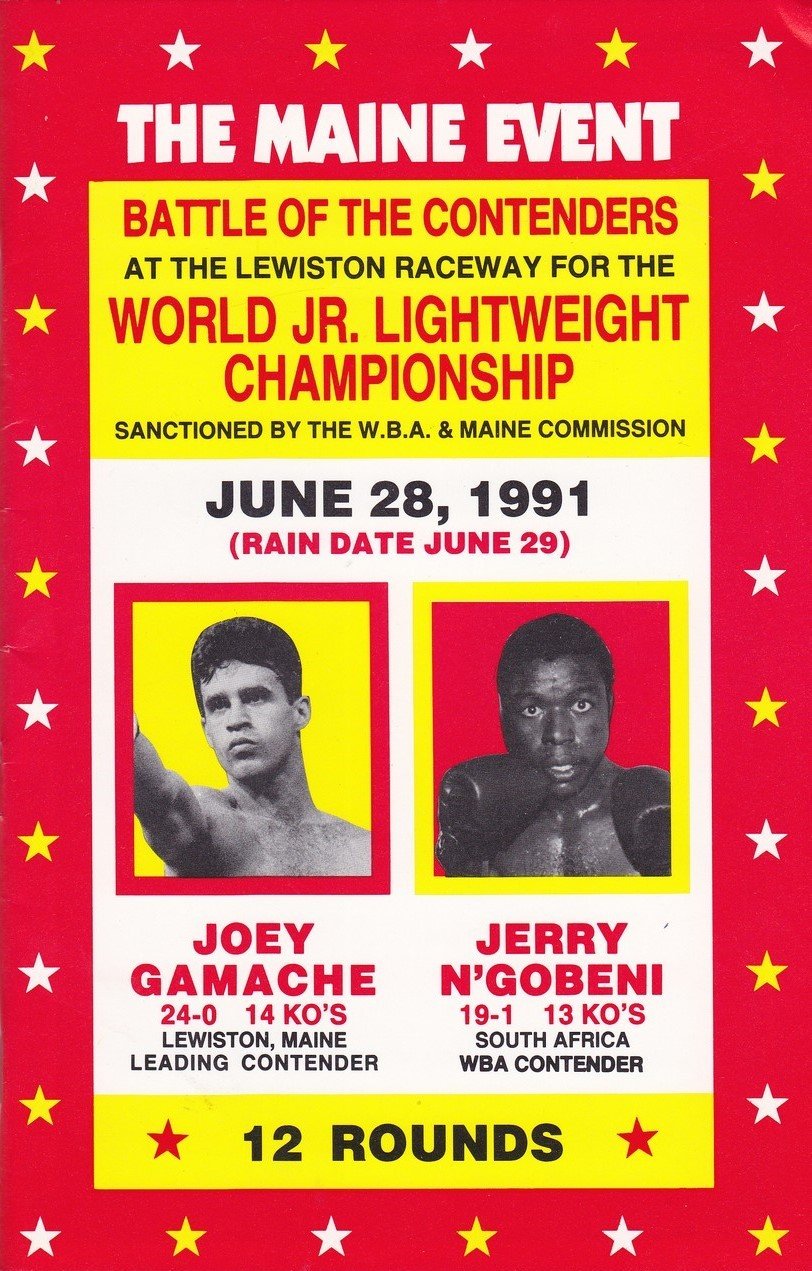Best I Faced: Joey Gamache

Former two-weight world champion Joey Gamache was hugely popular in Maine and is the only fighter to this day from that state to win a world title.
Gamache, who was the second youngest of six children, was born in Bathe, Maine, on May 20, 1966. He came from a blue-collar family; his father ran a Drywall company and his mother was a housewife.
“My father was strict but a good strict,” Gamache told The Ring. “He took me and my brothers to work early on, even if it was just to sweep floors. My father wanted us to do something and not get in trouble. Little by little we learnt the trade. It was a family effort.”
In his formative years, the young Gamache enjoyed sports, particularly baseball. His father would take some of the neighborhood kids out to play one of American’s number one pastimes.
“A baseball league started and my father signed me up and they put me at third base,” Gamache recalled. “My father noticed I had a kind of loop of a toss and he said, ‘Joe, we’ve got to get you to a gym and build your arms up.'”
It was a slow burn, but Gamache continued to develop and before he knew it, boxing had become his main focus.
Gamache was a talented amateur. He won the New England junior Olympics and national junior Olympics. As a senior, he lost in the final of the National Golden Gloves in 1984 and the semi-final stage of the 1984 Olympic trials.
Early on, his father had recognized his son’s potential to be a popular local attraction and began promoting him.
“He built me as a ticket seller, he kept my name out there,” explained Gamache. “[He] put those shows on as an amateur and crowds kept coming and they would see me fight.”
The young fighter’s ability caught the attention of legendary manager/ trainer Cus D’Amato, however, Gamache decided he wanted to gain more experience and fought internationally for America.
Despite the success, Gamache expected to join the family business after finishing school until his father suggested going professional.
“To finance everything, to be the promoter and invest in me, he sold his sports cards – baseball, hockey, football, basketball,” recalled the former world champ. “There was a lot of money. [He had] Ted Williams, Babe Ruth, Joe DiMaggio, the best of the best. He took that money, put it into the shows, invested into me and made everything come together. We started building crowds from the beginning.”
After going 97-13 as an amateur, Gamache turned professional with a third-round stoppage over Al Jackson in May 1987.
 The hometown hero fought mostly at home, all the while gaining experience and moving through the ranks.
The hometown hero fought mostly at home, all the while gaining experience and moving through the ranks.
He won his first 24 fights and was nicely positioned with the WBA at junior lightweight. When reigning champion Brian Mitchell had to vacate his title to face Tony Lopez in their rematch, that opened the door for Gamache, who was matched against once-beaten South African Jerry Ngobeni. The fight took place outdoors at the Raceway, Lewiston, in June 1991.
“It was a dream come true,” Gamache said of his world title coronation. “I stopped him in the later rounds (10th). It was a decent fight. I handled him pretty good.
“It came back to my dad making me a ticket seller. [Without that] I probably would have gone to South Africa.”
Gamache knew that his time at 130 was limited and headed south to Florida to train in the heat to see if he could make the weight again. It proved futile and the fighting Pride of Maine was forced up to lightweight.
He won three stay busy fights and due to his title success at 130, Gamache was ranked high at 135. When undisputed lightweight champion Pernell Whitaker vacated his titles, Gamache was matched against South Korea’s Chil Sung Jun to fill the WBA 135-pound vacancy.
“As an amateur, I had boxed on a show in Las Vegas – USA vs. Korea – so I was familiar with the style,” recalled Gamache, who was paid $140,000 and thrilled fans with a dominant ninth-round stoppage.
“He was a very aggressive, come-forward fighter, but I boxed the whole fight. We had a big fight at the Coliseum – 6,000 or 7,000 fans.”
In his first defense, Gamache was matched with former titleholder Tony Lopez, who was looking to rebound from losing the Mitchell rematch.
“He did good numbers [in Sacramento], but I was champion and we wanted to have every advantage we could have,” said Gamache, who received a purse of $130,000. “I thought my style was a good style to beat him because I was the boxer – a thinking man – and I knew he was aggressive.
“There was a headbutt early on and my eye swelled. I was legitimately winning going into the 11th round. The referee had forgotten he had called a headbutt and my eye was real swelled up. I caught some shots in the 11th round and they stopped the fight. They should have gone to the scorecards – it was a hard loss.”
Gamache got back to winning ways and yearned for another title opportunity. In the meantime, the WBA title had been passed from Lopez to Dingaan Thobela to the then-largely unknown Orzubek Nazarov.
A deal was brokered to bring the Japanese-based Kyrgyzstan-born fighter to Portland, Maine. In the region of 8,000 locals packed the Cumberland Civic Center in the hope of seeing their hero crowned champion for a third time in the fall of 1994.
“When I fought Nazarov, I didn’t make any money at all,” Gamache revealed. “We gambled to pay him all the money. I don’t know what he got, maybe $250,000. [I got] no purse. We took a big risk to fight at home. It was either going to be here or his backyard. We figured let’s not take any money, give the money to Nazarov, and we’ll fight for the title in Portland, Maine.”
It was a disastrous evening for the local favorite.
“That was wham bam, thank you ma’am,” admitted Gamache, who was cut under his right eye in the opening round, dropped three times and counted out in Round 2. “He caught me quick. I remember staying inside and doing some head movement, but he caught me with some clean shots. If you get caught in the right spot you can go.”
 Gamache wasn’t finished. He reeled off several wins and met the legendary Julio Cesar Chavez in Anaheim, California, in October 1996.
Gamache wasn’t finished. He reeled off several wins and met the legendary Julio Cesar Chavez in Anaheim, California, in October 1996.
“I figured Chavez isn’t at his best anymore, and I felt I had a style that could give him some problems,” explained Gamache, who made a career high $250,000. “When you see the fight, it shows me boxing, shifting, moving and working the jab. I lost but it was a competitive fight, it wasn’t just a one-way fight, I was in that fight.”
Gamache stayed relevant in the late 1990s and wanted more one more opportunity. He approached then-head of programming for HBO Sports Lou DiBella about a fight with Arturo Gatti.
DiBella liked the idea and placed it on the undercard of Oscar De La Hoya-Derrell Coley at Madison Square Garden in February 2000.
“I knew Gatti had some losses and I knew he was a tough guy,” said Gamache. “He could box but he was a big puncher. I felt, I’m a boxer, I can do well with him.
“We had some problems agreeing to the weight – I wanted it at 147. When I fought Chavez, I fought at welterweight but I’m not a welterweight. I’m a smaller guy but they had wanted it at 140. We said, ‘OK.’
“He got on the scale, [the weight] goes up and he gets off the scale. My manager, Johnny Bos, jumps out to the New York State Athletic commission and says, ‘He hasn’t made weight,’ but they wouldn’t put him back on the scale.”
The next night, Gatti proved too much for Gamache. The nature of the defeat prompted Gamache to retire from boxing with a record of 55-4 (38 KOs).
“It was a bad knockout – he was too strong, a young guy,” Gamache acknowledged. “When that happens, any fighter has to look back and think maybe it’s time to get out of this. I couldn’t take any chances on getting hurt. I felt I’d been very fortunate in my career and not taken bad beatings. With Nazarov it was quick; it wasn’t like Micky Ward and Arturo Gatti taking a lot of shots.”
However, his case against the New York State commission rumbled on.
“We ended up in a big lawsuit with the commission,” Gamache recalled. “The judge could see there was some wrongdoing. Nothing against Gatti, we all liked him for his accomplishments.”
In retirement, Gamache went to work under the great Emanuel Steward for a couple of years before setting out on his own. Among other fighters Gamache has worked with are Otto Wallin, Andy Lee, Kermit Cintron, Teofimo Lopez and Vasiliy Lomachenko. He was in Lopez’s corner the night he upset Lomachenko and was head trainer of Wallin when he almost shocked Tyson Fury.
“Beating Loma was very special,” Gamache said. “Teo didn’t just use power, he used intelligence.
“When you really look into the Fury-Wallin fight, it’s obvious they should have stopped the fight. Fury had 48 stiches. His cut was worse than Vitali Klitschko’s versus Lennox Lewis.”
Gamache, now 56, lives in New York City with his married and has two sons.
He graciously took time to speak to The Ring about the best he faced in 10 key categories.
BEST JAB
Julio Cesar Chavez: His jab was a really good fundamental jab – good stiff arm. It’s something that’s not talked about a whole lot, but it surprised me. A very underrated jab.
BEST DEFENSE
Chavez: He was deceptive, he knew how to move his head well.
BEST HANDSPEED
Arturo Gatti: His speed was pretty good, it stood out. He threw nice punches, clean shots.
BEST FOOTWORK
Chavez: Chavez was more a front foot fighter but I’d have to go to Chavez. He knew how to cut that ring off, get on the front foot. He knew how to attack, whether he’s shifting right or left, he knows how to get the shots off.
SMARTEST
Chavez: Chavez had that ring IQ even though he was at the end of his career. You see why he went so far – deceptive things – you’ve got to be smart to do that.
STRONGEST
Gatti: He was stocky and went from junior lightweight to welterweight and carried the weight. His physical strength allowed him to fight in some wars.
BEST CHIN
Chavez: We know Chavez had a good chin. I guess you’d have to say him. He fought all of top guys. You didn’t see him down until he fought Frankie Randall.
BEST PUNCHER
Gatti: I wouldn’t say Chavez; he knew how to wear you down. Probably Gatti, I felt his size and explosiveness. Nazarov’s power was solid.
BEST BOXING SKILLS
Chavez: He boxed coming forward, he knew how to put his punches together, and he knew how to move his head. You could see how he was so successful through his career and I caught him at the end.
BEST OVERALL
Chavez: Of course, I’d have to say Chavez. His whole body of work – you don’t have that kind of consistency and longevity without having good tools.
Questions and/or comments can be sent to Anson at [email protected] and you can follow him on Twitter @AnsonWainwright














